
In Love With Dutch Gap (part 1)
January 11th, 2018
Michael and I spent a week in Virginia this Christmas, sharing the holidays with my parents. And I managed three outings to Dutch Gap, each of them wonderful in its own way.
Dutch Gap is a conservation area on the James River and one of my favorite places in the world. A rather superlative statement, I know, especially for someone who has birded Costa Rica, but Dutch Gap is special to me. In summer, it's about the beautiful Prothonotary Warblers, brilliant golden birds who nest in tree holes in wooded swamps. At Dutch Gap they nest in bird boxes built especially for them, erected six feet or so above the water. You seem to hear their song around every corner. And they are easy to see, at least until you take your camera out.
But this time of year it's about the ducks. A diverse and abundant assortment of them winter in the marshes of Dutch Gap, viewable right from the roadside. They can sometimes become quite tame. My high counts this trip included, among others, 40 American Wigeons, 100 Gadwall, 10 Northern Pintails, 40 Northern Shovelers, and a whopping 160 Wood Ducks. (Those counts are all loose but conservative, based on what I could see with binoculars and spotting scope from the various overlooks. There were doubtless more!)
I guess ducks are some of my favorite birds. They have such character about them. The gentle Gadwalls, the stern yet comical Ring-Necked Ducks, the ungainly Shovelers. And for the first time I was able to capture them well. I fell in love anew with each species as I was processing their photos.
My first outing, on the 23rd with Michael, had me in a sorry state. I was worn out from travel and having difficulty adjusting to being away from home. But the marshes lifted my spirits.
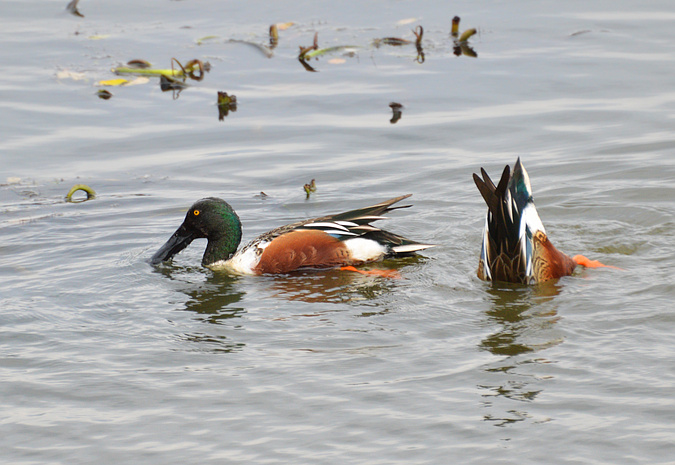
A Northern Shoveler dabbles for food with his oversized bill, while another tips up. There were dozens of them swimming close in that day.

Northern Shovelers have comb-like structures called lamellae on the edges of their oversized bills. As they dip their bills in the water, the lamellae strain out tiny crustaceans and other food items.
I noticed a few of them doing something I'd never seen them do before. Two ducks would slowly spin together while dabbling, creating a gentle vortex with them at its center. It was reminiscent of what phalaropes do, and likely for the same purpose (to draw food items up to the surface), but the shovelers preferred to do it in pairs. Visually they reminded me of a yin yang.
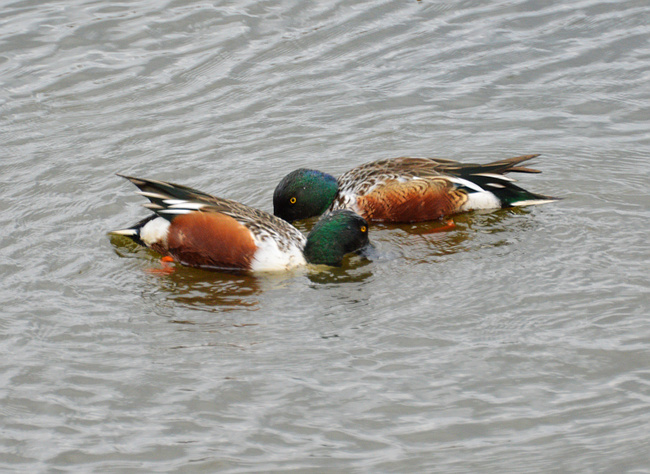
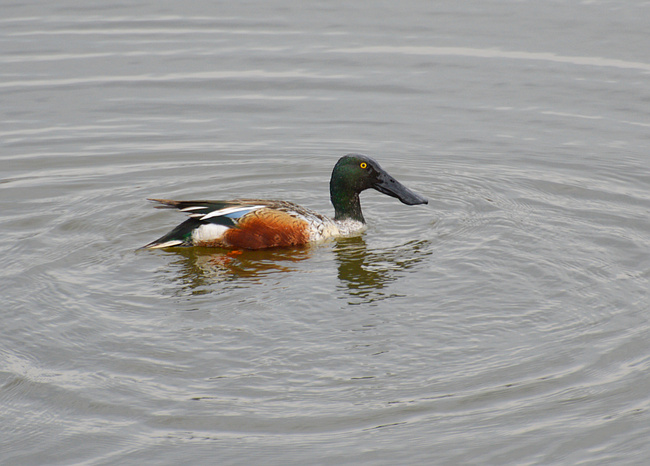
Note the vortex around this fellow. I think this is one who was spinning by himself.
The other stars of the day were the Ring-Necked Ducks. These diving ducks like shallower water than their relatives, and often hang out with dabblers in marshes and ponds, while the more dedicated divers keep to rivers, lakes and ocean bays. I had struggled to do the shovelers justice in the overcast lighting that day, but for the ring-neckeds it was no problem at all. They're naturally monochrome.
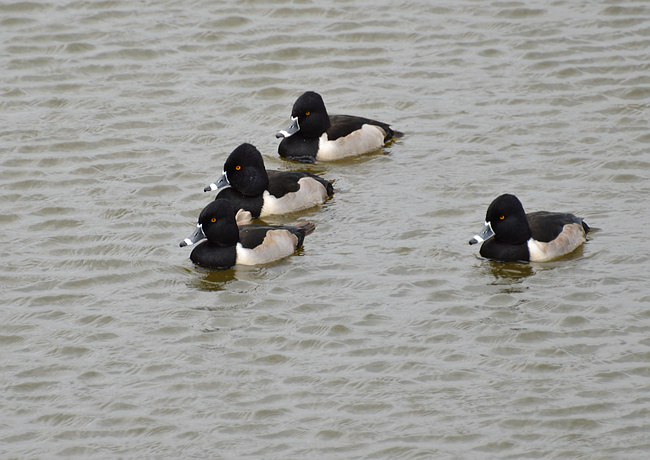
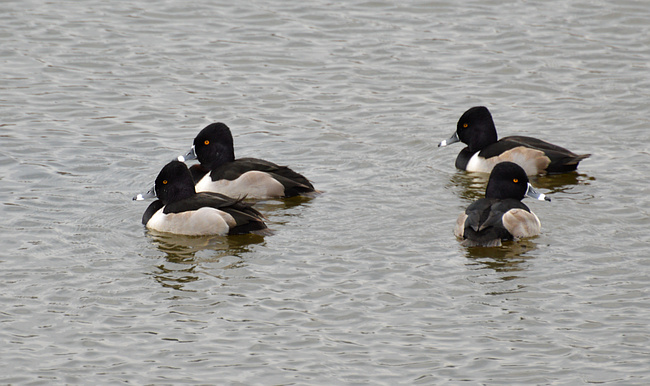
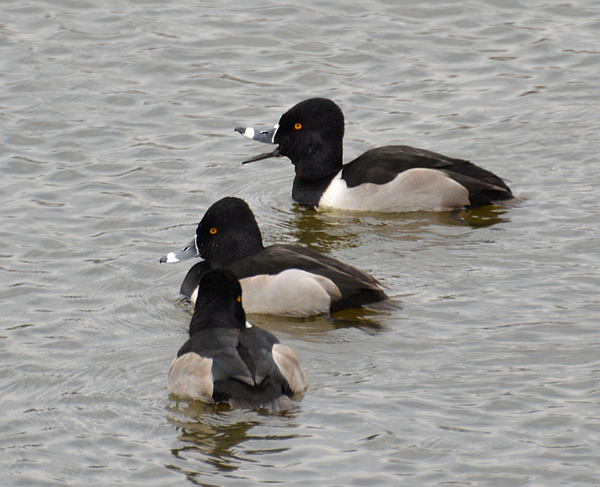
(If you're wondering why these ducks are called "Ring-Necked" and not "Ring-Billed", you're not the first. They do have a very subtle chestnut ring around their necks, visible at close range--as in, to someone who is holding a specimen in their hands. It is seldom seen by the rest of us.)
Dutch Gap in winter also features American Coots. I think of them as "honorary ducks" since they usually act like ducks and associate with ducks, but their chickenlike bills give them away as oddballs. They're actually part of Rallidae, the Rail family. Most of their relatives do more walking than swimming.

And in the "boring birds doing interesting things" category, this pair of Ring-Billed Gulls. I couldn't decide at first whether what they were up to was amorous or aggressive. (Final verdict: aggressive.)


January 11th, 2018
Michael and I spent a week in Virginia this Christmas, sharing the holidays with my parents. And I managed three outings to Dutch Gap, each of them wonderful in its own way.
Dutch Gap is a conservation area on the James River and one of my favorite places in the world. A rather superlative statement, I know, especially for someone who has birded Costa Rica, but Dutch Gap is special to me. In summer, it's about the beautiful Prothonotary Warblers, brilliant golden birds who nest in tree holes in wooded swamps. At Dutch Gap they nest in bird boxes built especially for them, erected six feet or so above the water. You seem to hear their song around every corner. And they are easy to see, at least until you take your camera out.
But this time of year it's about the ducks. A diverse and abundant assortment of them winter in the marshes of Dutch Gap, viewable right from the roadside. They can sometimes become quite tame. My high counts this trip included, among others, 40 American Wigeons, 100 Gadwall, 10 Northern Pintails, 40 Northern Shovelers, and a whopping 160 Wood Ducks. (Those counts are all loose but conservative, based on what I could see with binoculars and spotting scope from the various overlooks. There were doubtless more!)
I guess ducks are some of my favorite birds. They have such character about them. The gentle Gadwalls, the stern yet comical Ring-Necked Ducks, the ungainly Shovelers. And for the first time I was able to capture them well. I fell in love anew with each species as I was processing their photos.
My first outing, on the 23rd with Michael, had me in a sorry state. I was worn out from travel and having difficulty adjusting to being away from home. But the marshes lifted my spirits.

A Northern Shoveler dabbles for food with his oversized bill, while another tips up. There were dozens of them swimming close in that day.

Northern Shovelers have comb-like structures called lamellae on the edges of their oversized bills. As they dip their bills in the water, the lamellae strain out tiny crustaceans and other food items.
I noticed a few of them doing something I'd never seen them do before. Two ducks would slowly spin together while dabbling, creating a gentle vortex with them at its center. It was reminiscent of what phalaropes do, and likely for the same purpose (to draw food items up to the surface), but the shovelers preferred to do it in pairs. Visually they reminded me of a yin yang.


Note the vortex around this fellow. I think this is one who was spinning by himself.
The other stars of the day were the Ring-Necked Ducks. These diving ducks like shallower water than their relatives, and often hang out with dabblers in marshes and ponds, while the more dedicated divers keep to rivers, lakes and ocean bays. I had struggled to do the shovelers justice in the overcast lighting that day, but for the ring-neckeds it was no problem at all. They're naturally monochrome.



(If you're wondering why these ducks are called "Ring-Necked" and not "Ring-Billed", you're not the first. They do have a very subtle chestnut ring around their necks, visible at close range--as in, to someone who is holding a specimen in their hands. It is seldom seen by the rest of us.)
Dutch Gap in winter also features American Coots. I think of them as "honorary ducks" since they usually act like ducks and associate with ducks, but their chickenlike bills give them away as oddballs. They're actually part of Rallidae, the Rail family. Most of their relatives do more walking than swimming.

And in the "boring birds doing interesting things" category, this pair of Ring-Billed Gulls. I couldn't decide at first whether what they were up to was amorous or aggressive. (Final verdict: aggressive.)


| ← | → |

Mike
January 11th, 2017 at 11:11 pm
Not shown: many pics of Shoveler butts?
It was a very pleasant place to visit, and the pics bring back good memories.